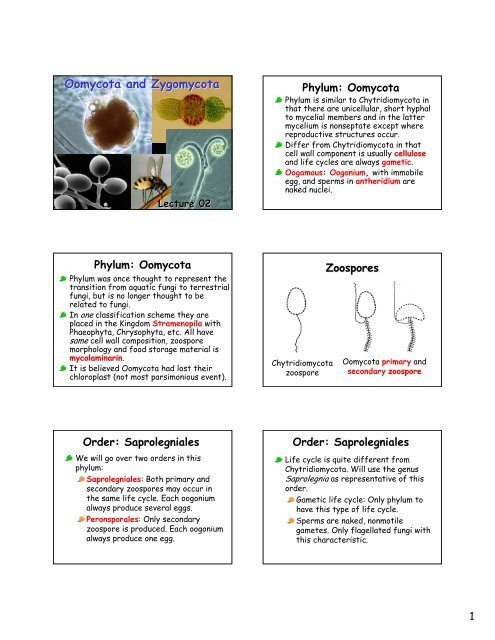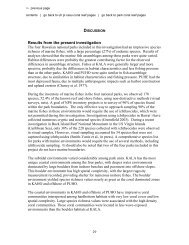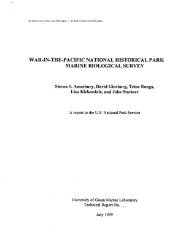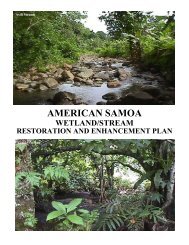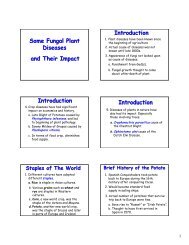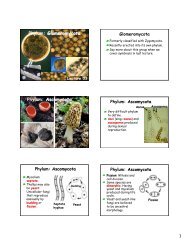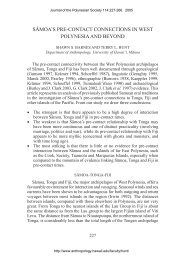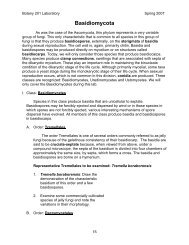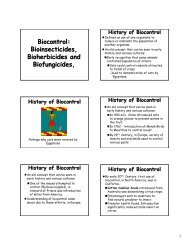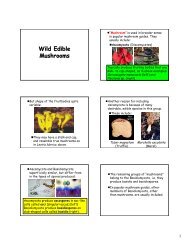Oomycota and Zygomycota
Oomycota and Zygomycota
Oomycota and Zygomycota
You also want an ePaper? Increase the reach of your titles
YUMPU automatically turns print PDFs into web optimized ePapers that Google loves.
<strong>Oomycota</strong> <strong>and</strong> <strong>Zygomycota</strong>Lecture 02Phylum: <strong>Oomycota</strong>Phylum is similar to Chytridiomycota inthat there are unicellular, short hyphalto mycelial members <strong>and</strong> in the lattermycelium is nonseptate except wherereproductive structures occur.Differ from Chytridiomycota in thatcell wall component is usually cellulose<strong>and</strong> life cycles are always gametic.Oogamous: Oogonium, with immobileegg, <strong>and</strong> sperms in antheridium arenaked nuclei.Phylum: <strong>Oomycota</strong>Phylum was once thought to represent thetransition from aquatic fungi to terrestrialfungi, but is no longer thought to berelated to fungi.In one classification scheme they areplaced in the Kingdom Stramenopila withPhaeophyta, Chrysophyta, etc. All havesame cell wall composition, zoosporemorphology <strong>and</strong> food storage material ismycolaminarin.It is believed <strong>Oomycota</strong> had lost theirchloroplast (not most parsimonious event).ChytridiomycotazoosporeZoospores<strong>Oomycota</strong> primary <strong>and</strong>secondary zoosporeOrder: SaprolegnialesWe will go over two orders in thisphylum:Saprolegniales: Both primary <strong>and</strong>secondary zoospores may occur inthe same life cycle. Each oogoniumalways produce several eggs.Peronsporales: Only secondaryzoospore is produced. Each oogoniumalways produce one egg.Order: SaprolegnialesLife cycle is quite different fromChytridiomycota. Will use the genusSaprolegnia as representative of thisorder.Gametic life cycle: Only phylum tohave this type of life cycle.Sperms are naked, nonmotilegametes. Only flagellated fungi withthis characteristic.1
Order: SaprolegnialesOrder: SaprolegnialesSummary ofSaprolegnia lifecycle.Go cover asexualcycle first.AsexualCycleZoosporangiaof Saprolegniaare not welldifferentiatedfrom hyphae.Zoosporangia delimitedby septum at base <strong>and</strong>dense protoplasm.Zoosporangiawith primaryzoospores.Order: SaprolegnialesOrder: SaprolegnialesDense ProtoplasmBasal SeptumTerminal Zoosporangium of SaprolegniaPrimary zoospores(posterior flagella)are released fromzoosporangium.Zoospore swims for aperiod of time <strong>and</strong>encysts: rounds up <strong>and</strong>cell wall forms arounditself.EncystPrimaryzoosporeCystOrder: SaprolegnialesCyst will germinateto give rise tosecondary zoospore(laterallyflagellated).SecondaryzoosporeOrder: SaprolegnialesSecondary zoosporeencyst.Cyst germinates togive rise to diploidmycelium.2
Order: SaprolegnialesSummary ofSaprolegnia lifecycle: Sexual stage.The sexual stage ismore uniform thanthe asexual. Mostspecies arehomothallic asshown here.SexualCycleOrder: SaprolegnialesTypically, oogonia<strong>and</strong> antheridia formon same mycelium.Nuclei migrate intogametangia, followedby formation ofsepta to “trap”nuclei. Meiosisoccurs at this time.Formation ofgametangiaAntheridiumOogoniumOrder: SaprolegnialesOrder: SaprolegnialesFertilizationTubesPlasmogamyTypically, oogonia <strong>and</strong> antheridia form onsame mycelium.Oogonia with several eggs ischaracteristic of this order. Antheridiaare always difficult to see in live orprepared material.Order: SaprolegnialesOrder: SaprolegnialesKaryogamy occurs inoogonium to formzygotes.The mature zygotesare referred to asoospores.Oospore germinatesto form the diploidmycelium.The mycelium willgive rise to both thezoosporangia <strong>and</strong>gametangia, i.e.,antheridia <strong>and</strong>oogonia.3
Order: SaprolegnialesOrder: SaprolegnialesVariations occur in zoosporangia. Twocommon genera:Saprolegnia: Following release ofzoospores, an internal proliferationoccurs to produce anotherzoosporangium.Proliferation ofzoosporangiumthrough previouszoosporangiumPreviouszoosporangiumOrder: SaprolegnialesAchyla: Primary zoosporesare released <strong>and</strong> encyst,immediately.Following release ofzoospores, a newzoosporangium forms belowthe septum <strong>and</strong> adjacent toold zoosporangium.EncystedzoosporesOrder: SaprolegnialesEncystedzoosporesAchyla empty zoosporangia with encystedzoospores at tip. Note formation of new,lateral zoosporangium.Order: PeronosporalesThis order has some of the most wellknown pathogens. They include thegenera Pythium <strong>and</strong> Phytophthora.Differs from the Saprolegniales inproducing only secondary zoospores in azoosporangium that is differentiatedfrom hyphae, <strong>and</strong> one egg per oogonium.Order: PeronosporalesZoosporangium of Phytophthoratropicalis releasing secondary zoospores.Note that the zoosporangium can readilybe distinguished from hyphae.4
Phylum: MicrosporidiaUntil the 1990’s this genus wasclassified as a very early eukaryote:Anaerobic, intracellular parasite ofarthropods.Genus lacks mitochondria.Was originally assumed to haveevolved before acquisition ofmitochondria.Based on sequencing of protein treeof beta-tubulins is a fungus!Phylum: MicrosporidiaUntil the 1990’s this genus wasclassified as a very early eukaryote:Placement among other phyla offungi uncertain at this point.Phylum: MicrosporidiaSpore germination:AnchoringdiskrupturedPolar tubePierce hostcell if nearbyPhylum: <strong>Zygomycota</strong>This phylum represents the first groupof terrestrial fungi, but still has somecharacteristics in common with theflagellate fungi:Mycelium is coenocytic.Although asexual spores are notmotile, they are still produced in asporangium.Above characteristics not found inother terrestrial fungiPhylum: <strong>Zygomycota</strong>Once thought to be more closelyrelated to flagellated fungi <strong>and</strong>classified in Phycomycetes (literallyalgal fungi) with flagellated fungi.Cell wall material, however, is composedmostly of chitin. This <strong>and</strong> other fungalcharacters places this taxon with thefungi, in the strict sense.Phylum: <strong>Zygomycota</strong>Characteristic that defines phylum isformation of the zygospore duringsexual reproduction.Zygospore formation usually resultsfrom the fusion of isogametangia:gametangia that are morphologicallyidentical.The life cycle of Rhizopus stoloniferwill be used as the representative ofthis phylum.5
Rhizopus stolonifer LifecycleRhizopus stolonifer life cycle includesboth sexual <strong>and</strong> asexual reproduction.Rhizopus stolonifer LifecycleStolonSporangiumdevelopmentNuclei migration,up sporangiophoreRhizoidsWill cover asexual cycle first.Rhizoids formwith contactwith substrateRhizopus stolonifer LifecycleRhizopus stolonifer LifecycleDevelopingSporangiumNuclei migrateinto swollen tipColumella formstrapping nucleiin futuresporangiumMatureSporangiumCell wall formsaround eachnucleus to formsporangiosporesor just sporesColumellaRhizopus stolonifer LifecycleSporangiumruptures, releasingair-borne sporesGerminationRhizopus stolonifer LifecycleAsexual reproduction will continue aslong as there is available food.Sexual reproduction will not take placeunless a different mating strain ispresent.The two mating strains are designatedas “+” (plus) <strong>and</strong> “-” (minus).Mycelium6
Rhizopus stolonifer LifecycleRhizopus stolonifer LifecycleTwo mating strains are allowed to growtogether.“+” (Plus)Mycelium“-”” (Minus)MyceliumSexual reproduction will take placewhere mating strains meet in center.Plus <strong>and</strong> minusProgametangia growtogether due tophermonal response.Nuclei migrate totips ofprogametangia.SuspensorsGametangiaRhizopus stolonifer LifecycleRhizopus stolonifer LifecycleGametangia fuse,followed byplasmogamy <strong>and</strong>karyogamy to formmultinucleatezygote.ZygoteZygote develops athick, pitted wallreferred to as thezygospore.Zygospore has a longdormancy periodbefore meiosis <strong>and</strong>germination occurs.Does not disperse!ZygosporeRhizopus stolonifer LifecycleDevelopingGermination of sporangiumzygospore forms asporangiumcontaining “+” <strong>and</strong> “-”sporangiospores.SporangiophoreZygorhynchus molleriGerminatingzygosporeA species that is homothallic <strong>and</strong>produces anisogametangia.7
Phylum: <strong>Zygomycota</strong>There is a great deal of variation in theasexual stage of the <strong>Zygomycota</strong>:Rhizopus is representative ofsimplest <strong>and</strong> what is believed to bethe earliest sporangia from whichother variations are derived.Phylum: <strong>Zygomycota</strong>Syncephalastrum produces spores incylindrical sporangiole.Phylum: <strong>Zygomycota</strong>Cunninghamella produces a one sporedsporangiole <strong>and</strong> is believed to be themost recently derived condition.8


